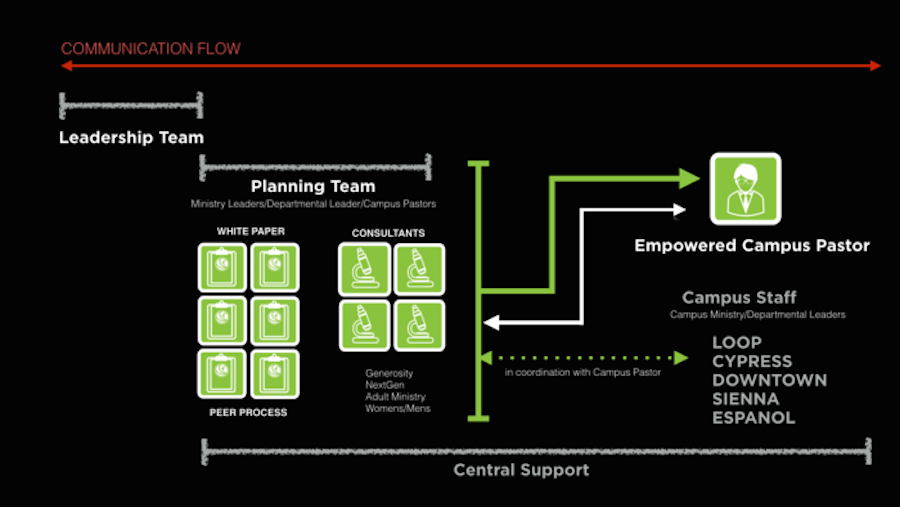Article
How to Create a Solid Communication Framework in a Multisite Model
If you are going to plant a grape vineyard, don’t plant apple seeds.

The telephone game is the usual analogy when talking about bad communication within a group or organization. However basic, this camp game helps us get to a starting place when talking about communication flow. The original message, if left untended, can get so garbled on its journey from point A to point B that you need a Windtalker (movie reference) to sort things out.
In this post, my hope is to help untangle things before they get a chance to get balled up. We certainly haven’t perfected communication, but we have made it a point to create a clean framework in which our leadership and locations can process information. Basically, you are seeing the results of hundreds of mistakes and the prescribed remedy in our multisite church model that we endeavor to use on a daily basis.
First: Establish Core Values
This is not just business talk. This is farm talk too. It could be stated as “Find Your Roots.” If you are going to plant a grape vineyard, don’t plant apple seeds. Assess the roots from which your model will grow. Our “big four” are as follows:
- We are about EXTENDING ministry to the lost, not about EXPANDING a church brand.
- We focus on NEIGHBORHOODS not regions.
- We are about CREATING, NOT CLONING by placing a high value on church context and location.
- We are about each location being led by an EMPOWERED CAMPUS PASTOR.
Many of you have worked through this exercise. Placing these “roots” or “core” convictions at the front of the signal chain is going to aid team cohesion and cut down on the clutter of unclear expectations.
Second: Find Your Flow
In the infographic above, we spell out our best-case scenario for information flow within our church. I can promise you we jack this up all the time, but for the most part it has helped us find our way forward.
Here are some observations to note:
- Solid Tier 2 Team: “The Planning Team” is made up of ministry leaders, campus pastors, and departmental heads. There are 16 people on this team and we meet monthly.
- White Paper and Consultants: It has been helpful for us to identify two streams that feed into the larger flow: Experts and Best Practices. Notice that this model does not include Team Leads/Global Pastors etc. for age and stage ministries. We have chosen instead to cultivate a team of “Consultants” to help advise campuses on specific issues and tasks that arise. These consultants help coordinate, but do not have direct authority over their counterparts at other locations. We have made the deliberate choice to keep the authority on the campus pastor level (I’ll explain next). We have also attempted to wean ourselves from policies that restrict to best practices that educate. Our attempt at objective white papers exist to help people solve problems. On our best day, if we could provide a trail of breadcrumbs helping people understand the “why and how” behind processes and project management, we will count it as a win.
- In our model, the Campus Pastor hires his own staff in consultation with the Planning Team—this is the part where the control freaks start sweating. Not to worry, we have a rigorous hiring process that involves our Human Resources Department. If your church doesn’t have a similar department, then form a team to vet potential hires. The main point of the Empowered Campus Pastor is that he lives and breathes the air within his context of ministry (rural, urban, suburban, etc.) and is able to determine how best to translate our core DNA to his segment of the congregation. Also, it means the people that report directly to him don’t have a boss on the local campus level and another boss at “headquarters.” This has yielded tremendous fruit as our Campus Pastors build their teams.
- Finally, notice that Central Support or Central Services is not on top of the hierarchy, but in a supporting position “beneath” or throughout the flow. If there is anything “global” or “intra-campus,” it is the site neutral team members that make up Central Support that are involved on a daily basis with all the campii. (We like to use this made up word and drop it in emails for no particular reason)
Third: Teach, teach, teach.
I think it might be an “Andystanleyism”, so I’ll give him credit here before I say it but: “What is celebrated is repeated.” Any parent, educator, or scientist named Pavlov knows this to be true. It is indeed the truth when we are leading our teams through this communication flow. Give time in meetings and in personal notes to celebrate great steps in the process. Remind people about “who to go to” when asking a question or presenting an idea. In our case, reinforce the role of the Empowered Campus Pastor. It will awaken the “entreleadership” (Ramsey) instincts of high performance teams and reinforce to them that they are not just a cog in a machine, but a key player in an ecosystem that is pushing the Gospel forward in an effective way.



